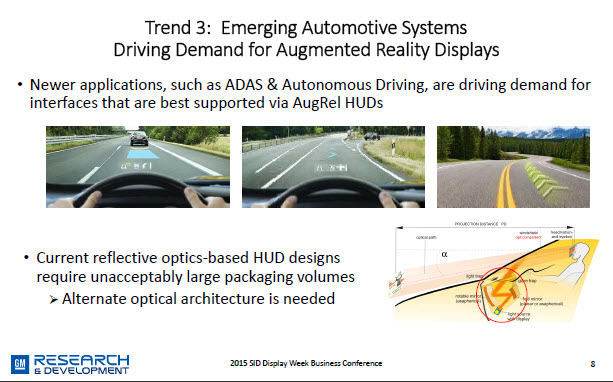The first speaker in the final section was Thomas Seder, Chief Technologist for the HMITBD group at General Monitors. He said that GM’s main strategy is to try to increase the performance of products without adding cost.
One of the main aims is to match the quality of consumer devices. GM has defined its own idea of what is needed in automotive. At the moment, displays are at around 150 ppi, but will go up to 220 to 250 or so, as this is probably the point of diminishing returns when used in a car. The second area is to look at bigger colour spaces. In automotive, most displays are around 65% of NTSC, but in the future that will go up.
Consumers also appreciate better black levels in their displays. That will mean that in the future cover lenses and optical stacks will be replaced by optically-bonded solutions to reduce reflections.
A big trend will be a move away from rectangular form factors (“the mother of all is the Tesla”). The latest Mercedes “cries out” for a flexible or conformed display, where at the moment two rectangular displays are used. Looking at concept cars, all designers want organic and curved edge displays. (See our video Sharp Frees Auto Makers from the Tyranny of Rectangles.)
Many concepts for HUDs are about “Annotating reality”, not augmenting reality. GPS is really important for HUDs and Google is going to level 4 automation, where the user never needs to control the car, but for lower levels of automation HUDs will be useful. Sometimes, when the car is in control it’s like “watching a teenager drive” – it makes the driver nervous. Giving the user an idea of the intention of the car can really help them relax.
For real AR applications you need a really wide field of view and at the moment, that takes too much space in the car, and that is unacceptable to car makers, so new technologies are needed. Seder said that current HUDs can use 4/5 litres of space, but would have to use 20 or more for the field of view that he would like to see. (He needs to talk to Ostendo – see our video Ostendo Shows Impressive Microdisplays.)
In questions, holographic waveguide HUDs were identified by GM as the most promising technology. Traditional reflective optics have really got to the end of the line because of the optical path needed. At the moment, companies such as Rockwell Collins and BAE are developing this technology in aviation.
OLEDs are being looked at seriously in cars for a couple of years time. Barry Young of the OLED Association asked what the main problem is for OLED. James Carpenter of GM said that the differential ageing of OLED is a real problem. The materials are also a problem in the extreme temperatures of cars. Brightness is also a challenge. Finally, LCDs are so much cheaper. Wong of EDO confirmed that although it has automotive displays, 50K hours of lifetime are not possible.

